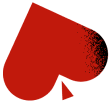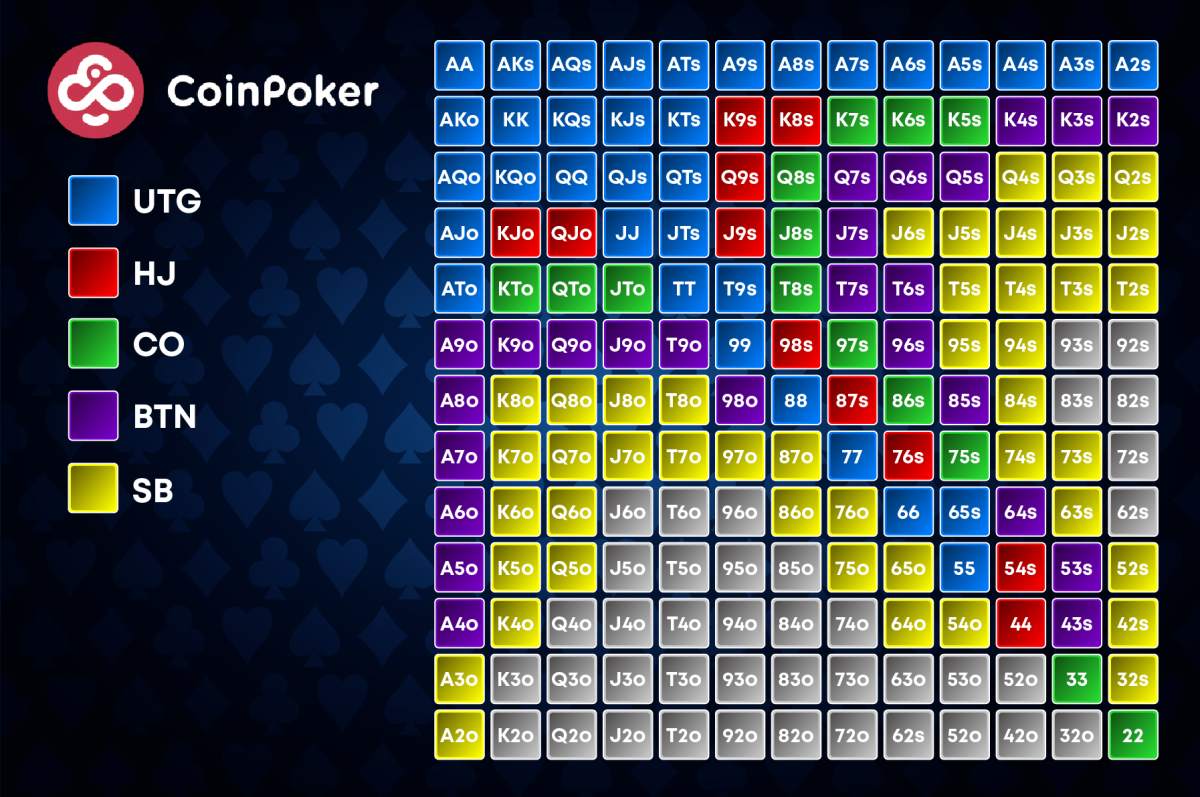
Poker Cheat Sheet
Detailed Poker Hands Cheat Sheet Guide
The game of poker can be very difficult for beginners. Especially if they have to play against more seasoned players, who can easily tell who’s the least experienced at the table and take advantage of that.
Of course, being familiar with the rules is far from enough to be competitive in cash games. Experienced players will easily recognize amateurs (“fish”) by their style of play and moves they commonly make, although this may not be obvious to the naked eye or to the “fish” itself.
In order to avoid this, it’s best to have some sort of a reminder about the most important tricks, statistics, charts, and calculations. This is how a poker cheat sheet can help a beginner in the game – it can provide players with concise info and quick advice on how to act in key moments.
Hand rankings chart
First of all, a new player should know how poker hands are ranked, from strongest to weakest. Actually, he shouldn’t just know the rankings, but he needs to recognize winning hands in a fraction of a second, which is not always easy for those who lack experience.
So having a little hand ranking cheat sheet can be very useful for players who still need some time to determine just exactly how strong their hand is. For this purpose, you can refer to the chart below:
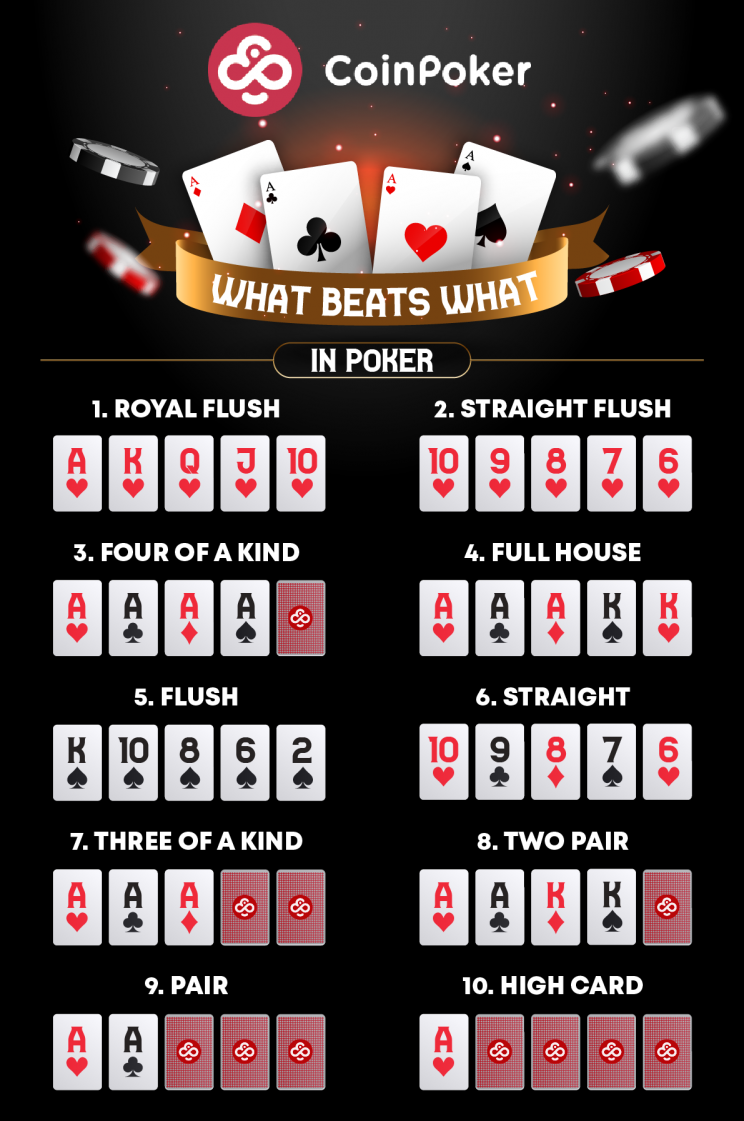
Poker hand odds
But just how often can you connect these hands? How reasonable are the odds of drawing them? Let’s see the numbers for 5-card and 7-card poker games.
| 5-card games | 7-card games | |
| Royal flush | 0.00015% | 0.0032% |
| Straight flush | 0.0014% | 0.028% |
| Four of a kind | 0.024% | 0.17% |
| Full house | 0.14% | 2.60% |
| Flush | 0.20% | 3.03% |
| Straight | 0.39% | 4.62% |
| Three of a kind | 2.11% | 4.83% |
| Two pair | 4.75% | 23.5% |
| A pair | 42.3% | 43.8% |
| High card | 50.1% | 17.4% |
For obvious reasons, it’s much easier to connect any of these hands in 7-card games. Still, some of these happen almost never – you need to play thousands of hands to even see a royal flush come out at some point. This table tells you a lot about which hands are worth waiting for on the flop, the turn, and the river, and which ones you shouldn’t seriously count on. It also suggests that a pair, and even a two pair in 7-card games aren’t too likely to win, especially on full ring tables.
Positions in poker
Starting positions are extremely important in poker. Players at the early positions (players that act among the first by the order of play) are usually handicapped and players in late positions have an advantage over them.
This is because late positions have more info on other players, derived from their behavior and how much they bet at which point. Also, they can take advantage of the fact that some players will probably fold before their turn, which will leave them with less competition or no competition whatsoever. This will affect their decisions and players in late positions are generally encouraged to play more hands and make more risks.
6max table positions
The names of positions, as well as the advantages they provide, depend on the number of players. On tables that have a maximum of 6 players, they usually go like this, from left to right:
Under The Gun (UTG) – this is the earliest position, as UTG acts first pre-flop. However, post-flop, UTG doesn’t necessarily act first, if SB and/or BB are still active.
Hijack (HJ) – also known as the middle position (MP), sits immediately to the left of UTG and acts right after him
Cutoff (CO) – acts after HJ
Button (BTN) – the player on the button is formally the dealer – the position got its name after the dealer button. BTN sits to the left of CO. It’s probably the most beneficial position, as the button gets to act last in post-flop rounds, while in pre-flop only SB and BB act after him. However, BTN doesn’t have to put any blind bets before the start of the hand, unlike SB and BB, so it could be argued that this is the best position.
Small Blind (SB) – SB gets to act second-to-last pre-flop, which is great, but gets to act first in every post-flop round. Also, SB has to put a small, pre-determined blind bet before the start of the hand to compensate for this fact.
Big Blind (BB) – BB acts the last pre-flop, which has its advantages, but in a way SB and BB act first, since they have to place a blind bet before the start (BB places a bet twice as big as SB). Also, post-flop, BB acts second, and if SB folds, BB will play first until the end of the hand.
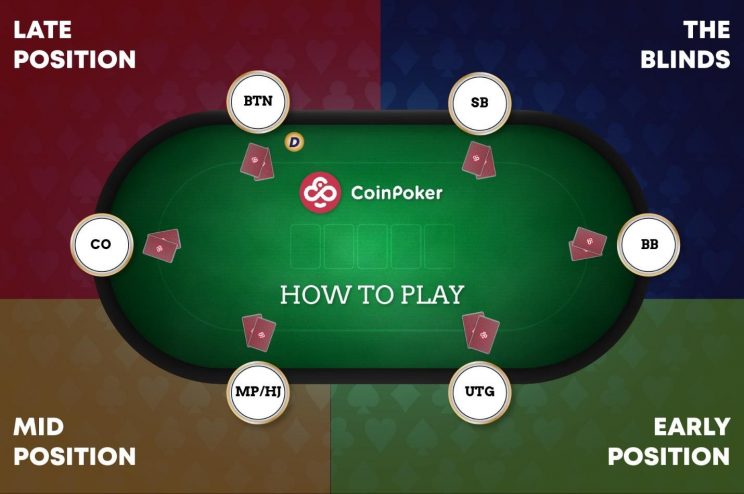
Full ring positions
In full ring games, where there are 6-9 players, the terminology may vary for different positions. But usually, you’ll find these phrases to denote positions at the table:
- UTG
- UTG + 1
- UTG + 2
- Middle position 1 (MP1) or LoJack (LJ)
- Middle position 2 (MP2) or HiJack (HJ)
- Middle position 3 (MP3) or Cutoff (CO)
- Button (BTN)
- Small Blind (SB)
- Big Blind (BB)
Opening hands in Texas Hold ‘em chart
What some beginners still don’t understand is that poker is a game of careful calculations and well-optimized practices. We’re not saying there’s no room for inspiration and improvisation, but in the long run, it’s smart to stick to some proven practices set by of players who’ve played this game.
The opening hands’ selection chart is based on such practices. Let’s check out this chart:
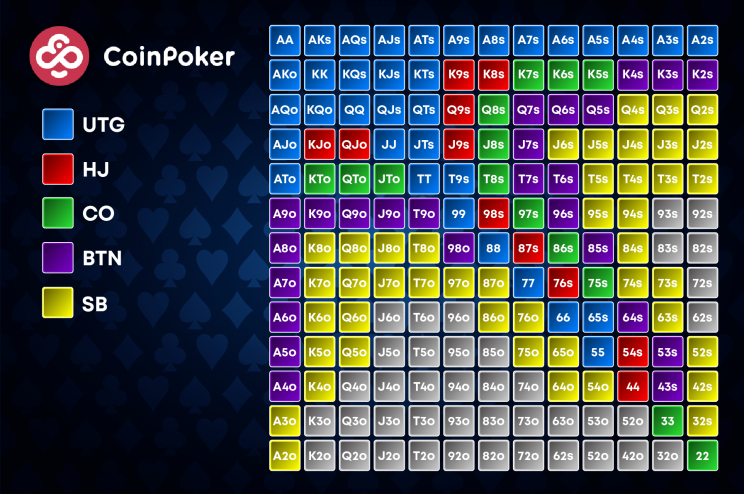
What you see in this table are all the possible combinations of hole cards in Texas hold ‘em poker in 6max games. Just to make it clear, “s” means that the two cards are suited, while “o” means that they’re off-suited.
This chart tells us which combinations of hole cards you should use to open-raise, and different colors denote different starting positions. Have in mind that a single field doesn’t represent a single combination of cards but a number of them. For instance, there are 4 different KQs combinations, although they all fall under a single field: K♥ Q♥, K♠ Q♠, K♣ Q♣, K♦ Q♦.
For the KQo field, there are even more potential hands – as many as 14. In total, there are 169 fields that represent 1326 unique combinations.
This chart entails that nobody has entered the pot before you, and all the white fields mean that you shouldn’t either. It’s usually better to fold in these situations. This amount of folding may surprise a novice player, but drawing a winning hand with any of these combos is very difficult.
We can also notice that early positions are supposed to raise tighter and be more careful. For instance, UTG should raise only with a very tight range of hands, while the player on the button has much more freedom to raise the bet. So BTN should raise with cards in purple fields, but also with those in green, red, and blue fields. SB has the widest range, which makes sense since SB has already put some money in the pot before that start and folding would mean he loses that money automatically.
Keep in mind that this chart can’t be applied to games with antes. If you play with antes, you’d need a new chart that will suggest raising with a wider range of pocket cards. This happens for the same reason that forces SB to play more aggressively pre-flop – it’s harder to give up on a hand in which you’ve already invested something.
Finally, this chart is in no way engraved in stone. It’s conditional and simply serves as a good starting point for players, especially if you have no additional info on other players. However, the way you play your opening hands should always depend on how aggressive other players at the table are as well as on your own style of play.
Opening hands in PLO
However, you also have to remember that different variants of poker will sometimes be wildly different when it comes to determining the best possible starting hands. We’ll take the example of PLO.
If you just tried to use the similar logic you would use in Texas hold ‘em, you wouldn’t be completely wrong. Some high pairs, when combined, do bring players a lot of equity. And that’s no surprise.
But notice how straight draws are also highly rated – much higher than in Texas hold’em. This also makes sense, as you have more opportunities to connect these hands with 4 hole cards, even though you can use only 2 of them. So a hand like 8, 9, 10, J is actually the 8th strongest starting hand despite the fact that you need to draw 3 suitable cards in order to connect a straight.
This is the nature of PLO, since a lot of it comes down to your chances to have as many outs as possible post-flop. And with straight draws like 8, 9, 10, J, you’ll have so many opportunities on the flop. The number of possible straight outs after the flop can be much bigger than in Texas hold ‘em. The maximum straight draw in Texas has 8 outs, while PLO can have as much as 20. Straight draws that give a player more outs than any Texas hold ‘em hand (9 or more) are called “wraps”.
You can also see that the second best possible hand in PLO is not a pocket two pair. It’s rather A, A, J, 10. With A, A, J, 10 you have good chances to hit a high straight, plus you hold the pocket aces as a backup. Thus J, 10 is more valuable with these aces than a pair of queens, simply because you won’t be able to use both your pocket pairs at the end of the hand anyway. On the other hand, with A, A, J and 10 you can legitimately hope for two high pairs.
Pot odds and equity
The pot odds basically represent the reward to risk ratio post-flop, based on the size of your opponent’s bet and the size of the pot. What you need to spend in order to call is the risk, and the size of the pot is the potential reward.
So if for instance, you need to bet $50 to call, and the pot is worth $150 after that, this means that your pot odds are 3:1. You can use this formula:
risk/(risk/reward)
to turn that into percentages, which turns out to be 25% in this case.
Why are pot odds important?
Pot odds are very important if you’re calculating whether a bet is worth calling. The rule is quite easy – if you calculate your equity and it’s smaller than this percentage, you should generally fold. If your equity is larger than that, it is advised that you call.
The quickest way to get to a rough estimation of your equity is by counting the number of outs. For instance, if you have 8 outs on the flop, your equity is around 34%, but if you have 20 it goes up to 86%. After the turn, if you don’t connect the desired hand, your chances will naturally fall since there’s only 1 card left to be drawn. In this stage, every out you have will amount to around 2% of equity.
However, sometimes it’s not easy to calculate all that in your head in real-time, so here’s the chart that turns the number of your draws into an estimation of your equity. Remember, you should only call if your equity is higher than your pot odds.
| Number of outs | Number of cards left | |||
| 2 | 1 | |||
| Ratio | Precentage | Ratio | Precentage | |
| 1 | 22.5 : 1 | 4.3% | 46 : 1 | 2.13% |
| 2 | 10.9 : 1 | 8.6% | 22.5 : 1 | 4.26% |
| 3 | 7 : 1 | 12.9% | 14.7 : 1 | 6.38% |
| 4 | 5.1 : 1 | 17.21% | 10.8 : 1 | 8.51% |
| 5 | 3.9 : 1 | 21.51% | 8.4 : 1 | 10.64% |
| 6 | 3.1 : 1 | 25.81% | 6.8 : 1 | 12.77% |
| 7 | 2.6 : 1 | 30.11% | 5.7 : 1 | 14.89% |
| 8 | 2.2 : 1 | 34.41% | 4.9 : 1 | 17.02% |
| 9 | 1.9 : 1 | 38.71% | 4.2: 1 | 19.15% |
| 10 | 1.6 : 1 | 43.02% | 3.7: 1 | 21.28% |
| 11 | 1.4 : 1 | 47.32% | 3.3 : 1 | 23.4% |
| 12 | 1.2 : 1 | 51.62% | 2.9 : 1 | 25.53% |
| 13 | 1.1 : 1 | 55.92% | 2.6 : 1 | 27.66% |
| 14 | 1 : 1 | 60.22% | 2.4 : 1 | 29.79% |
| 15 | 0.9 : 1 | 64.52% | 2.1 : 1 | 31.91% |
| 16 | 0.8 : 1 | 68.83% | 1.9 : 1 | 34.04% |
| 17 | 0.7 : 1 | 73.13% | 1.8 : 1 | 36.17% |
| 18 | 0.6 : 1 | 77.43% | 1.6 : 1 | 38.3% |
| 19 | 0.5: 1 | 81.73% | 1.5 : 1 | 40.43% |
| 20 | 0.5 : 1 | 86.03% | 1.4 : 1 | 42.55% |
If you manage to calculate the ratio of your equity and your pot odds right and play consistently over longer periods of time, you can expect these periods to be reasonably profitable. But you’ll also need to watch other players’ moves and try to figure out their hands in order to get a better estimation of your true equity.
For this purpose, you can use various software that will help you determine it. You just type in what you’re holding, your best estimates about what the others are holding (you can update this during the hand), as well as cards on the board. Once you do that, the software will give you the best possible evaluation of your current equity.
Most important metrics in poker
Speaking of software, don’t forget that there are fully legal pieces of software you can use to your advantage when playing online poker. Probably the most useful ones are those that can track and record moves by other players at the table to provide you with detailed insights about their playing style and routines.
In order to get a relevant sample, you’ll need to play a lot of hands against a particular player, but if you manage to do it, it’s worth it. You won’t (or at least shouldn’t) make all the same moves against a tight player as you’d do against aggressive ones, and determining how experienced a player at your table is can also be of vital importance.
Here are some of the key statistics you should pay attention to:
VPIP (voluntarily put money in the pot) – this number denotes the percentage of times a certain player decided to put his money in the pot, at any stage of the game. Or in other words, the percentage of hands that a player normally plays. This is generally a reliable way of telling how loose or tight this player is. Most moderate 6max Texas hold ‘em players will have a VPIP of 20-25%.
PFR (pre-flop raise percentage) – PFR shows how frequently a player chooses to raise pre-flop. This metric is best used in combination with VPIP. A big gap between the two indicates that a player often limps, which is almost always a sign of lack of experience. Only recreational players don’t understand the power that raising has over calling in poker. Try to exploit that.
3bet% – this stat shows the percentage of times a player chooses to re-raise before the flop. Experienced players will usually have 3bet% of around 5-10. Those who 3bet more often tend to be overly aggressive, and sometimes less seasoned. Also, they’re obviously inclined to re-raise using a very wide range or to bluff quite often, so you can use this info to your advantage. Or if your hand is too weak, you know you shouldn’t test their eagerness to re-raise and maybe it’s better to just fold.
Fold to 3bet – this one is even simpler: it’s a percentage of times a certain player has folded after a 3bet. Obviously, the higher this percentage is, the more often you should re-raise when playing against these players.
For anyone who’s still a beginner in the world of poker, we hope you got a better insight into how the game of poker works, thanks to this little collection of tips, tricks, and reminders. Keeping this cheat sheet by your side while playing online poker can help you react faster in the game and it can be something to build your further poker knowledge on.
Of course, it won’t be enough as you’ll need to study the game further and you’ll need a ton of experience to understand all the little details that make all the difference. The more you play, the less you will use the cheat sheet and it’ll gradually just become a part of your game.
To start building your experience, register on Coinpoker and start playing now!
Hai trovato questo articolo utile?
Non riesci a trovare quello che stai cercando?
Contattaci e facci sapere come possiamo aiutarti.
Contattaci













